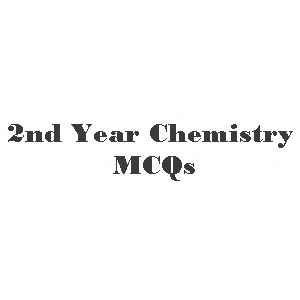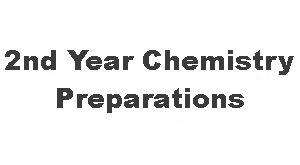Check out the 2nd Year Chemistry Alkyl Halides MCQs here with answers. Alkyl Halides consists of Alkyl and Halogen groups. They have a different nomenclature. They are prepared by alcohol. In Alkyl Halides, there are two main components for their Reactivity. They are C-X bond energy and C-X bond polarity. They undergo Substitution Reactions. In Alkyl Halides, there are two types of reactions. The first one is Nucleophilic Substitution Reaction in which Sn2 and Sn1 occur. The Second one is Beta-Elimination Reaction in which E2 and E1 occur. The most important one about Alkyl Halides is Grignard Reagent. It is the derivative of Alkyl Halides. Grignard Reagents reacts with different compounds and forms a new product. So, this is a brief intro to this chapter. Check out the important MCQs of this chapter given below.
2nd Year Chemistry Alkyl Halides MCQs

KEY POINTS
- Alkyl Halides/nomenclature
- Preparation of Alkyl Halides
- Reactivity of Alkyl Halides
- Reactions Alkyl Halides
- Grignard Reagent
Question#1: Elimination of bimolecular reactions involve?
- 1st order kinetics
- 2nd order kinetics
- Zero-order kinetics
- None of these
Answer
Answer
Question#2: Which one of the following species is not an electrophile?
- NH3
- Br+
- H+
- BF3
Answer
Answer
Question#3: Which one among the following is not a good leaving group?
- HSO4–
- Cℓ
- OH–
- Br–
Answer
Answer
Question#4: AlkyI halides are considered to be very reactive compounds towards nucleophile because________.
- They have an electrophilic carbon
- They have an electrophilic carbon and a good leaving group
- They have an electrophilic carbon and a bad leaving group
- They have a nucleophilic carbon and a good leaving group
Answer
Answer
Question#5: The alky halide molecule on which the nucleophile attacks is called_________.
- Electrophile
- Leaving group
- Substrate
- Electrophilic center
Answer
Answer
Question#6: Which of the following is correct about SN2 reactions?
- Breakage of C—X and formation C—Nu bonds are simultaneous
- Inversion of the configuration of the alky I halide molecule
- 2nd order kinetics
- All of these
Answer
Answer
Question#7: Which of the following is correct about SN2 reactions?
- Retention of the configuration of the alky I halide molecule
- Unimolecular
- The reaction rate is a function of the
- All of these
Answer
Answer
Question#8: β-elimination reactions are due to:
- Attack of the incoming nucleophile on alpha hydrogen
- Attack of the incoming nucleophile on beta hydrogen
- Attack of the incoming nucleophile on beta hydrogen
- Attack of the incoming nucleophile on electrophilic hydrogen
Answer
Answer
Question#9: Primary alkyl halides give:
- E2 and SN2 reactions
- E1 and SN2 reactions
- Either E1 or E2 reactions
- SN2 and E1 reactions
Answer
Answer
Question#10: Tertiary alkyl halides give:
- SN1 and E1 reaction
- SN2and E2 reaction
- SN2 and E1 reaction
- None of these
Answer
Answer
Question#11: AlkyI halides react with Zn in the presence of aqueous HCI to form:
- Alkynes
- Alkane
- Alkenes
- None of these
Answer
Answer
Question#12: Which of the following is alkyl halide?
- CH3 CI
- C2 H4 CI2
- CH2 CI2
- All of these
Answer
Answer
Question#13: The hydrolysis of Grignard s reagent yield:
- Alcohol
- Ketone
- Aldehyde
- None of these
Answer
Answer
Question#14: Most stable carbonium ion is:
- (CH3)3-C- +CH2
- +CH3
- (CH3)3 –C+
- CH3–+CH-CH3
Answer
Answer
+CH3
Question#15: Order of SN1 reaction:
- 1
- 1.5
- 2
- 3
Answer
Answer
Question#16: Chloromethane is used in?
- Production of silicone polymer
- Manufacturing of butyl rubber
- Petroleum refining
- All of these
Answer
Answer
Question#17: Which one used in containers and pipework for reactive and corrosive chemicals.
- Silicone polymers
- Steel
- Teflon
- none of these
Answer
Answer
Question#18: If an electrophile is an attacking reagent which one is most reactive?
- R-1
- R-CI
- R-BR
- R-F
Answer
Answer
Question#19: Which statement is incorrect about the reactivity of alky I halides?
- Great the bond energy of R-X, the lesser the reactivity
- Great the bond polarity of R-X, the lesser the reactivity
- Great the bond energy of R-X, smaller the stability
- Great E.N different of R-X greater the stability
Answer
Answer
Question#20: Which statement is incorrect about nucleophilic substitution reaction?
- The incoming nucleophile must be stronger than the leaving one
- The leaving nucleophile must be stronger than the incoming nucleophile
- Tertiary alky I halides generally give SN1 reactions
- SN2 is a single step mechanism
Answer
Answer
Question#21: SN1 reactions are favored in which solvent?
- Nonpolar
- Polar
- Slightly polar
- All solvents
Answer
Answer
Question#22: In β –Elimination the resulting product is?
- Alcohol
- Alkane
- AlkyI halide
- alkene
Answer
Answer
alkene
Question#23: Which compound is most reactive?
- (CH3)3 CCI
- CH3CH2 CI
- (CH3)2CHCI
- All have the same reactivity
Answer
Answer
Question#24: When alkyl halide reacts with sodium metal in the presence of ether. Which product is formed?
- An alkane with even number carbons
- Alkene
- An alkane with odd number carbons
- Alcohol
Answer
Answer
Question#25: Which pair of reactant gives the ethyl acetate as a product?
- C2H5BR +CH3O
- C2H5BR +CN–
- C2H5BR +2[H]
- C2H5BR +CH3COONa
Answer
Answer
Question#26: Which pair of halogens are present in halothanes?
- F, I
- F, At
- F, CI
- CI, I
Answer
Answer
Question#27: Thioalcohol is prepared when alky I halide is reacted with:
- OH–
- SH–
- NO–2
- I–
Answer
Answer
Question#28: Which one is monohaloalkane?
- CH2 CI2
- CH3 -CH3 -CH 2 CI
- CHCI3
- CCI4
Answer
Answer
Question#29: Which one among the following is a good leaving group?
- OH–
- F–
- Cℓ–
- I–
Answer
Answer
Question#30: Tetraethyl lead is prepared by reacting ethyl bromide with?
- Pb
- Na4Pb
- Pd
- NH3
Answer
Answer
 Online Exams Tests Preparation
Online Exams Tests Preparation


